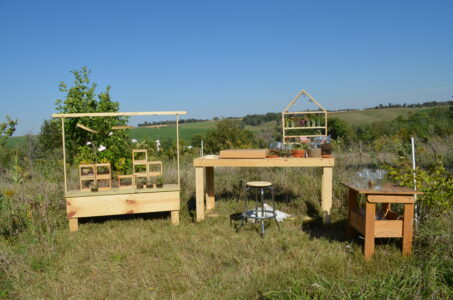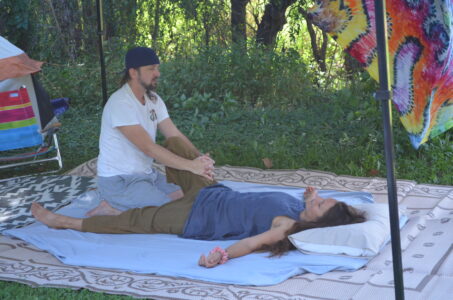No fence? No sweat
Virtual fencing saves time, labor

CONTRIBUTED PHOTO Adam Ledvina, owner of Blue Collar Goatscaping and Iowa Kiko Goats, relies heavily on virtual fencing for both of his businesses.
TOLEDO — Farmers looking to save time, energy and labor are more often turning to virtual fencing.
Adam Ledvina, who owns Blue Collar Goatscaping and Iowa Kiko Goats, said the brush management business relies heavily on virtual fencing, as does his international breeding stock business. He has used No Fence, which is based in Norway, for the past two years for his operation in Toledo.
Virtual fencing uses GPS-enabled collars and other wireless technology that are linked to an invisible boundary. When livestock approach the boundary, the collars emit a warning sound and if they don’t back away from the boundary, some collars can deliver a small electric shock.
“I’ll put the collars on the does but if they’re kidding, then I take them off. I’d hate for a goat to swing her head around and knock a kid in the head with one of the collars,” Ledvina said. “I also take them off for breeding season since there’s a lot of pushing. But I am slowly easing into running a full season with the collars.”
Ledvina spends a week or so training his goats to understand how the virtual fence concept works. He’s learned that the battery life on the GPS collars can wear down faster if the goats are in the trees a lot, since they’re solar charged.
“When the goats are in the paddocks, I make sure they always have access to the sun. If they’re in the dark, dense timber, I will catch and recharge the collars. I build my fences to make sure there’s a water source at all locations and also where the sun can reach the collars,” Ledvina said. “You save so much labor by not having to put up fence all the time.”
Another perk to using virtual fencing is that a farmer can track his animals with the GPS-enabled collars.
“I can check and see where they’re at at all times within the virtual fence perimeter,” Ledvina said. “We had over 500 goats. I have a smaller group where about 50 goats use the collars and then one or two in each herd, since they stay together. We have multiple properties and I usually keep 100 at each place.”
Ledvina started his brush management business first in 2013 with 20 goats then continued to add goats. He transitioned to Kiko goats after raising the other breeds and expanded his herd from 20 to 200 head. Then he added the breeding stock business and ships his product across the country and internationally.
Two years ago, Ledvina switched his attention to full-time for the goats.
“My grandparents on both sides farmed. I grew up on an acreage outside of town with my parents,” Ledvina said. “I have been open to technology like virtual fencing. As long as you have a good perimeter fence on the outside, you can rotationally graze safely inside that area.”
While the majority of Ledvina’s goats were easy to train, he said there’s always that one goat.
“She kept busting through the perimeter and wouldn’t learn the system. Sometimes you just have to remove those from your herd,” he said.
Daniel Faidley farms outside Colfax in Jasper County with his family. They raise corn and soybeans, and his brother has cows while Faidley has goats.
“Half the farm ground is in row crops while the other half is outbuildings and pasture ground. We have around 50 acres of timber and that’s where the goats come in,” Faidley said. “We use a single strand of electric fence for the cows, but I work full-time aside from the farm and I don’t have a lot of time to move fence. The first couple of summers we had the goats, I was going out and carving paths through multiflora rose and the timber. I was moving logs out of the way at least every other day and dragging the fence around. It was time consuming and a workout.
“Finally, I decided that virtual fencing would be a good option for us.”
Faidley said he learned about virtual fencing while at the Iowa State Fair. He’s used the collars for more than a year now and discovered that the training process with the goats was easy.
“We had some shocks and some escapes, but once the goats got used to it and understood what was going on, they adjusted well,” Faidley said. “We had a hiccup here or there, like a battery that died, but for the most part, the goats don’t like to be away from each other so they adjust easily to when I change the boundaries of the virtual fencing to expose them to more forage.”
The app associated with the virtual fencing also gives Faidley insight into his goats’ behavior.
“If you start getting a few more shocks, then that tells you they’re testing the boundaries because they don’t like what they have to eat in their perimeter. With intensive management grazing, you really want them to eat some things they don’t want to eat,” he said. “Also, if you look at the app and all dots are lumped together but there’s one that’s away from the group, that usually means it’s a goat kidding. It also helps me track the goats. There’s a button you can push within Bluetooth range and it’ll chime, so if a doe has burrowed herself down under logs and brush and kidded there, you wouldn’t have found her without the app.”
When his goats turn four or five months old, that’s when Faidley puts the collars on them. He said they’re like teenagers at that age. He has electric net fence around both sides of his driveway that wraps around the house and his acreage to keep the goats away from his wife’s prize roses.
“We’ve learned that, over time, a goat pruning of the roses is actually good for the plants,” Faidley said.





